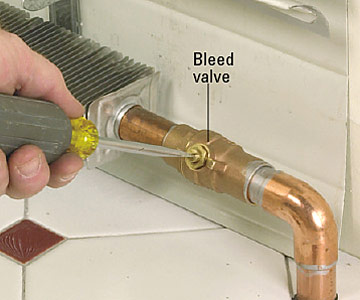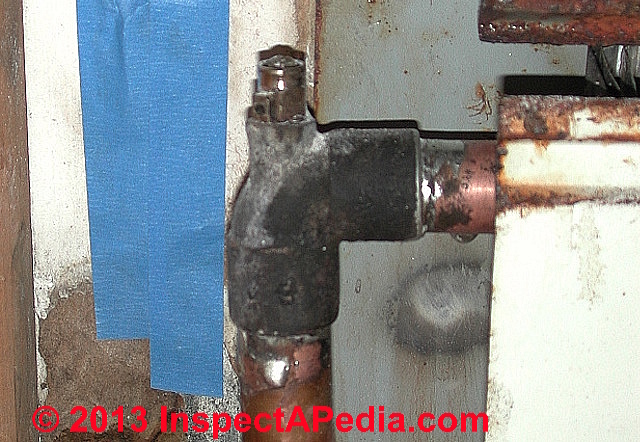There is so little heat being emitted (relative to the output of the boiler) and thermal mass to those zones is so low that the boiler is basically just heating itself up over several 10s of seconds, hitting the high limit and turning off. We'd have to look up the specs on the boiler model to come up with a reasonable estimate of the water-volume + cast iron thermal mass, but you're looking at maybe 25-30lbs of water in the bigger zones, even less in the basement zone, which isn't much. That's probably a
WGO6, which has 18 .4 gallons/ ~150lbs of water volume and probably another 50lbs of water-equivalent cast iron for a total of 230lbs (zone volume + boiler.) An output of 212,000 BTU/hr is 59 BTU per second. To raise 230lbs of water-mass equivalent 20F takes 20F x 230lbs= 4600 BTU, so at 59 BTU/second you're looking at a minimum burn time of about 78 seconds on a zone call, which is an EXTREME short cycle. Since it's emitting 400-500 BTU/hr per foot, the "excess" on the 80' zone is really "0nly" something like 172,000 BTU/hr , or about 50BTU/second, not 59, but that's not much of a difference. For that thing to hit it's AFUE ratings you'd need to have burn times north of 50 minutes (300 seconds). With that type of short cycling it's as-used AFUE is probably something like 70% best-case, for a boiler that's capable of 85% if sized properly to the load & radiation.
Even if all 196' of baseboard were being operated as a single zone, with 212,000BTU/hr of boiler output that's ~1080 BTU/hr per running foot, which is 25-30% more than the baseboard could emit with 220F water. Whoever installed that boiler on a system with such little radiation relative to the boiler is incompetent. There are no really good (read "inexpensive") solutions here. The options are a smaller "right sized" boiler, a monster-sized buffer tank to add thermal mass to the system, or quintupling the size of the radiation. The smallest oil boilers out there have a DOE output in the neighborhood of ~60,000 BTU/hr give or take, and that's probably the cheapest solution to the short-cycling (not that it's cheap.) With 60,000 BTU/hr of output and ~200' of baseboard, when all zones are calling for heat at once that's about 300BTU/hr per foot, which take an average water temp of about 140F, which means the return water entering the boiler is potentially in a condensing temperature zone for an oil boiler, but that can be corrected in the near-boiler plumbing with a bypass branch, 0r plumbing it primary/secondary. 60K into 80' of fin tube is 750BTU/hr-ft, which balances at an AWT of ~200F. But even if you run it at 180F out/160F back with an AWT of 170F, the 80' of fin tube is still emitting over 40,000 BTU/hr so the amount of excess heat is only 20,000 BTU/hr, nearly an order of magnitude lower than your current 172,000 BTU/hr. so tweaking the system to get 5 minute+ burns would not be difficult.
That's not much help for your current symptom, but something to think about before the price of oil heads north of $4/gallon again.
Batts don't shrink (unless mice have been using it as nesting material, which should be obvious.) Some 50-60 years ago it was pretty common to install half-depth R6-R7 "econobatts" into 2x4 framing. If you have a lot of wall area with econobatts, it's possible & desirable to blow cellulose into those cavities with a "dense-packing" tube inserted into a single ~2.5" hole (on either the interior or exterior), which will reduce the air leakage of the house significantly and lower the heat load of the house. This may be subsidized by the state or local utilities, which takes the sting out of it even further.
In an uninsulated CMU wall basement with half-inch sheet rock the above-grade portion of the wall is only worth about R1.5-R2, which has about 2-3x the heat loss per square foot of econobatt-insulated 2x4 (which means the total of eat loss through the ~3' of exposed foundation is about the same as through the full 9-10' height of one story of above-grade wall) and about 5x the heat loss per square foot of R13 fiberglass or dense-packed 2x4 construction. Since there is sheet rock over it it's a real project, but air-sealing & insulating the foundation sill & band joist, and insulating the CMU wall down to at least 3' below grade is still worth it, even at $2/gallon oil with a right-sized boiler, and even more so with a ridiculously oversized boiler that's short-cycling, and spending most of it's time in idle mode. With an insulated basement the standby loss alone of the oversized boiler would likely keep it as warm or warmer down there as the above-grade floors, and the basement zone thermostat would literally never call for heat. You can't insulate a basement in the same manner as the above grade floors due to moisture considerations. When you get to that point, refer back the remodeling forum on this site, where the details have been spelled out in multiple threads.



